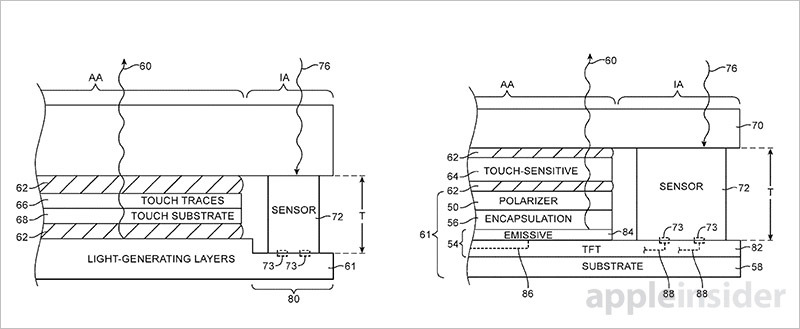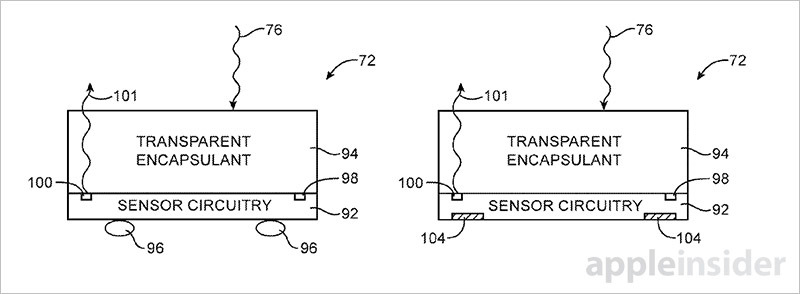Apple on Tuesday was granted a patent for embedding light-sensing sensors directly into device displays, an important step in creating a full-screen iPhone without the trademark "chin and forehead" bezels.
As noted in Apple's U.S. Patent No. 9,466,653 for "Electronic devices with display-integrated light sensors," light-sensing apparatuses are commonly displaced from the device display. While advantageous from a production standpoint, such implementations lead to wasted space, or in some cases force sleek designs to be modified. Indeed, the iPhone's proximity and ALS are positioned above the display near the handset speaker.
In a rethink of contemporary smartphone design, Apple proposes forming sensors on display layers that already boast the conductive traces needed for power. Most embodiments describe a method of overlaying the sensor on top of a display layer in a screen stack, whether it be OLED or LCD. Some embodiments provide for sensor positioning at the periphery of a device display beyond the edge of touch sensitive traces to avoid touch sensitivity issues.
Certain embodiments dispose an ALS or proximity sensor at the extreme edge of an OLED display abutting a touch-sensitive layer, for example. Alternatively, a handset could include a dedicated TFT layer onto which a variety of sensors are embedded. In each case, all display and sensor circuitry is protected by a transparent encapsulation layer made from glass or plastic.
The key to today's patent is the design. In each scenario, the sensor or sensors are disposed within the display itself, not above it as with current iPhone, iPad and Mac models. This design tweak alone would save precious millimeters off final design specifications and could pave the way to a true full-screen display.
Apple is said to be working on an advanced iPhone design with "full-screen face," meaning the rumored OLED display stretches across the device's entirety. Moving closer toward that goal, the company last week patented technology detailing a fingerprint sensor that works through portable device displays. The ear speaker remains a problem, though Apple could theoretically turn to a different audio technology and hide that component under the display as well.
Apple's embedded light sensor patent was first filed for in June 2015 and credits Erik G. de Jong, Anna-Katrina Shedletsky and Prashanth S. Holenarsipur as its inventors.
 Mikey Campbell
Mikey Campbell








-m.jpg)






 Christine McKee
Christine McKee
 Marko Zivkovic
Marko Zivkovic
 Mike Wuerthele
Mike Wuerthele

 Amber Neely
Amber Neely
 Sponsored Content
Sponsored Content
 Wesley Hilliard
Wesley Hilliard










24 Comments
This to me is minor compared to how they do the Home button functionality itself (not Touch ID).
One idea I've thought of is to move Control Center up top—to the right of Notication Center, and put down at the bottom gesture the Home screens. Either atop the app UI or the gesture pushes the current app out of the way to reveal your Home screen. Obviously there's potential for confusion here, but it is only one interaction. And yet, using a dedicated Home button is still a better design. Remains to be seen how they solve this one in a truly elegant manner.
I can also see why this bezel-free design is first only for the plus/pro model. Chop off the bezels and chins on a 4.7" design and you are chopping off a great deal of battery life.
Right now I see a forehead-free design as impossible. You cannot put an earpiece speaker in the display at this point. You need a hole to fit one in. The speaker will need to be above the display on some kind of bezel. And I can imagine a scene where they somehow mount a camera in the display, but I cannot imagine one for now where they put a 7MP FaceTime HD camera in there. My prediction is this iPhone 8 isn't completely bezel-free on all four sides.
This is both fascinating in terms of hardware and UI design. It's very difficult to achieve a no bezels design.
Think of it for a moment: You have the Home button, you have the earpiece, you have the light sensor and proximity sensor as well as the front facing camera. Each one of these is incredibly hard to almost impossible to embed within the display itself.
Almost as fascinating is the UI. Without a dedicated 'Home' button, how will users exit apps? Using multi-finger gestures? Maybe using an on-screen Home button equivalent? Placing the Home button on the side of the device?
I'm very curious about how they will solve all these issues. Amazing if they can pull it off.